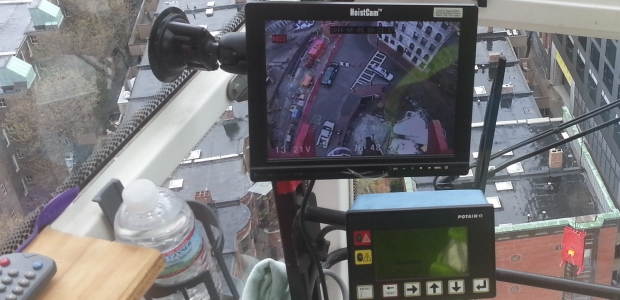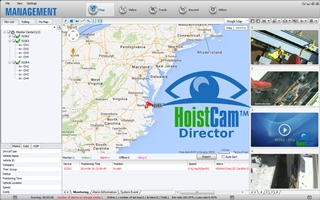
Seeing Safety Differently
Remote operated cameras aid in mitigating risk in construction work.
- By Christopher G. Machut
- Jan 01, 2017
Safety programs in construction have been shifting focus from reactive assessments to proactive measures designed to mitigate risk in real time. In an industry that accounts for nearly 20 percent of the nation's workplace fatalities, according to the Occupational Health & Safety Administration (OSHA), most construction leaders recognize that they can do better.
This fall, OSHA released its Recommended Practices for Safety and Health Programs. With an intended goal of reducing workplace injuries, OSHA's recommendations update a policy introduced more than 30 years ago. Rather than focusing on reaction to an event, these guidelines are meant to encourage businesses to implement proven, consistent safety practices focused on injury and accident prevention.
OSHA recommends that companies set goals, track results, and promote their success in the area of safety prevention. This recommendation provides guidance on creating a safety program, addresses multi-employer work sites, and includes step-by-step tools and additional resources for companies as they adopt a culture of safety. Today, there are tools and technologies that can be implemented to help companies and their employees practice safer behaviors on the job. One such technology is the use of remote operated camera systems, especially for the operation of heavy equipment and cranes.
Complex and blind lifts no longer need to rely on only radio communication and the use of hand signals because operators are able—using remote cameras affixed to the crane—to gain a clear and unobstructed line of sight. And while the safety benefits of gaining visibility are easily understood, there remains an even broader use of cameras for the purpose of achieving overall job site safety and productivity. When camera systems are tied into software programs that provide analytics for the employer, often with access from any desktop or mobile devices, monitoring safety can become a continuous and company-wide effort.
It is possible to use these monitoring systems to keep eyes on a job site, to quickly and remotely identify important safety practices, and ultimately prevent the unsafe activity from causing harm. Ben Hyson, a commercial insurance advisor with Brown & Brown in Norfolk, Va., sees the value in the use of cameras to mitigate risk. "We have many clients who use cameras in general, and there are carriers that will consider offering discounted rates for operators who use camera systems along with other good loss control practices in general," Hyson said.
While it is not yet considered an industry standard, Hyson sees the construction industry moving in that direction as time proves the benefit potential and businesses accept a demand for increasing transparency on job sites. He likens it to the adoption of backup cameras in cars, something that will be mandated in all cars manufactured by 2018.
"When used as a tool for crane operators, cameras can really improve the decision-making process by providing them with more complete information to do their job more safely," he added.
The Long View
OSHA's Multi-Employer Citation Policy reinforces a shared responsibility among different employers working within the same job site. General contractors and subcontractors are all held to a common standard of safety, even when a specific company’s employees are not exposed to a hazard. While this concept can be worrisome to employers who fear litigation, the idea behind this regulation is that workplace safety is the responsibility of every company and every employee involved.
 With such policies as a backdrop and facing the need to reduce accidents, it stands to reason that construction companies are placing greater emphasis on safety. Tools such as unmanned camera systems continue to evolve beyond providing visual confirmation for crane operators, to capturing and analyzing data that will help businesses with a wealth of safety and efficacy issues on any job site. There are products available today that can take information obtained from a variety of unmanned camera systems to analyze logistics and material delivery, equipment setup areas, and even monitor employee movement. Data can be gathered from cameras fixed to equipment, positioned throughout a job site, or captured from drone footage, and site managers can collaboratively manage workflow and share information within the organization or with various subcontractors. Operations managers or CEOs can increase productivity and profits by deploying or re-deploying personnel or equipment assets based on real-time needs. Risk managers can quickly assess operations to reduce opportunities for accidents or retrieve archived data following an accident for efficient incident investigation.
With such policies as a backdrop and facing the need to reduce accidents, it stands to reason that construction companies are placing greater emphasis on safety. Tools such as unmanned camera systems continue to evolve beyond providing visual confirmation for crane operators, to capturing and analyzing data that will help businesses with a wealth of safety and efficacy issues on any job site. There are products available today that can take information obtained from a variety of unmanned camera systems to analyze logistics and material delivery, equipment setup areas, and even monitor employee movement. Data can be gathered from cameras fixed to equipment, positioned throughout a job site, or captured from drone footage, and site managers can collaboratively manage workflow and share information within the organization or with various subcontractors. Operations managers or CEOs can increase productivity and profits by deploying or re-deploying personnel or equipment assets based on real-time needs. Risk managers can quickly assess operations to reduce opportunities for accidents or retrieve archived data following an accident for efficient incident investigation.
Advocates believe the ability to make every aspect of a construction site more transparent will, in time, provide businesses and even regulators with the confidence to recommend these practices as a standard across the industry. As the integration of camera systems with other critical programs grows, such as occupational safety monitoring, tracking man-hours, or cataloging progress as it happens, safety and efficiency will increasingly be interwoven into the business model.
The ability to provide real-time analytics is also underway in complementary sectors outside of construction, including industrial, marine, and transportation.
Seeing the Risk/Reward
Troy Pierce, vice president of Health Safety and Environment with TNT Crane & Rigging, agrees that as technology evolves, there will be more widespread deployment of camera and video technology to aid in job site management. As issues of cost, portability, and access improve in these remote operated systems, companies will have an increasingly hard time not implementing the technology.
When asked about the fear of litigation from capturing and storing images from a job site, Pierce acknowledged the apprehensions that have been voiced within the industry but was quick to point out that was not his chief concern. "We take great measures to ensure the safe execution of our lifts," he said. "If something were to go wrong, the use of a camera could help us understand exactly what happened and can provide a valuable learning opportunity."
He added that "big cranes carry big risk, but everyone is interested in being safe."
For Pierce, the use of remote operated camera systems provides a clear benefit on the job. When operating in situations that are highly complex, require tightly controlled coordination, and have poor site visibility, the use of a camera can help to ensure the safe execution of lifts. "Our feeling has always been that if there is a tool that will give the operator more assurances and confidence that the lift is free of obstruction, why wouldn't we want to use it?" said Pierce.
That philosophy was proven accurate after the very first experience that TNT had using a camera affixed to its crane on a job that involved the demolition and rebuilding of a collapsed parking garage. TNT utilized it for the job because the collapse had occurred when the top floor fell, setting off a chain reaction of collapse on lower floors while cars were parked in the garage—so there were specific challenges to clearing the site safely. "The crane operator was working within tight quarters and would have been operating blind for many of the lifts that were required," said Pierce. "This was a job that lent itself to the use of camera technology."
He reported there were no issues on the job. The crane operator had an added level of confidence with the use of real-time video, all lifts were completed with no damage to the site or equipment, and they were able to keep the project on time and on track. "Everything went off without a hitch, and we were very pleased overall," he said.
For now, TNT is selectively using the remote camera system on jobs where it will provide the greatest advantage. Pierce is convinced of the benefits but acknowledges the technology is expensive to deploy across the board, especially for a company that operates cranes all over the country.
This article originally appeared in the January 2017 issue of Occupational Health & Safety.